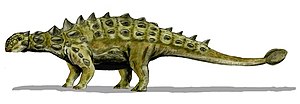Euoplocephalus
| Euoplocephalus | ||||||||||||
|---|---|---|---|---|---|---|---|---|---|---|---|---|

Live reconstruction of Euoplocephalus |
||||||||||||
| Temporal occurrence | ||||||||||||
| Upper Cretaceous (late Campanium to early Maastrichtian ) | ||||||||||||
| 76.4 to 69.9 million years | ||||||||||||
| Locations | ||||||||||||
| Systematics | ||||||||||||
|
||||||||||||
| Scientific name | ||||||||||||
| Euoplocephalus | ||||||||||||
| Lambe , 1910 | ||||||||||||
| Art | ||||||||||||
|
Euoplocephalus is a genus of bird pelvic dinosaurs (Ornithischia) from the group of Ankylosauria . She is one of the best known representatives of this group and lived in the Upper Cretaceous in North America .
features
General

Euoplocephalus reached a length of 6 to 7 meters and is one of the larger ankylosaurs, though the later living Ankylosaurus was greater. Its weight is estimated at 1.8 to 3 tons. Like all ankylosaurs, it was stocky and quadruped (it moved on all fours). The limbs were relatively short and strong, with the hind legs longer than the front legs, which positioned the head close to the ground. He probably had five toes on his front feet and three on his back feet, all of which ended in wide hooves.
Armor and tail lobe
Like all ankylosaurs, Euoplocephalus had armor made of osteoderms , i.e. skin bone plates that covered the head, back and parts of the tail. This armor consisted of transverse plates, which were embedded in the skin, in addition, they were provided with small bony humps that were arranged in rows. To support the heavy weight, the bones of the skeleton were partially fused together. Thus, the formed sacrum (sacrum) to the davor- and underlying vertebrae a called Synsacrum unit.
As with many Ankylosauridae , the tail ended in a bony club. It was connected to the last caudal vertebrae, and strong tendons ensured the mobility of this club, which could probably be used for defense.
skull
The skull of Euoplocephalus was massive and very broad and sat on a short neck. The top was also covered with armor made of bone plates, these were fused with the skull bones. Even the eyelids were protected and wore size-adapted bony oval disks. The snout ended in a broad, toothless hornbill, the teeth were small and leaf-shaped and adapted to a vegetable diet. Like some other ankylosaurs, Euoplocephalus had looped breathing ducts within the skull. This dinosaur had two pyramid-shaped horns on the back of its head, and a bony outgrowth also grew on each cheek. The brain was like all ankylosaurs very small.
Way of life
Presumably the heavy build of Euoplocephalus did not allow fast locomotion. In the event of a threat, it could have pressed itself to the ground to protect its unprotected stomach from attacks, and it could also have tried to drive away predators with blows of its tail. According to other opinions, the armor and the tail lobe could also have been used in disputes with conspecifics, for example over the mating privilege.
Euoplocephalus was a herbivore that probably fed on various plants growing near the ground. The small teeth did not allow thorough chewing of the food, presumably the food was only decomposed in the voluminous trunk. Some researchers think it is conceivable that the ankylosaurs had multiple stomachs, similar to ruminants .
Discovery and naming
The first description of the genus under the name Stereocephalus by Lawrence Lambe in 1902 was followed by the renaming to Euoplocephalus in 1910 , since a genus of insects was already called Stereocephalus . The name is derived from the Greek eu- / ευ- (= "good"), hoplon- / οπλον- (= "shield") and kephale / κεφαλη (= "head") and therefore means "well armored head". Numerous fossils , including 15 partially complete skulls and numerous parts of the postcranial skeleton, were discovered in Alberta ( Canada ) and Montana ( USA ). They are dated to an age of 76 to 69 million years in the Upper Cretaceous Period (late Campanium to early Maastrichtian ).
Systematics
According to the results of cladistic analyzes , Euoplocephalus was most closely related to the genus Ankylosaurus (after Fastovsky and Weishampel 2005). Accordingly, the two genera form an unnamed clade within the Ankylosaurinae, the younger, more highly developed Ankylosauridae .
literature
- Kenneth Carpenter : Ankylosaurs. In: James O. Farlow, Michael K. Brett-Surman (Eds.): The Complete Dinosaur. Indiana University Press, Bloomington IN 1997, ISBN 0-253-33349-0 , pp. 307-316.
- David E. Fastovsky , David B. Weishampel : The Evolution and Extinction of the Dinosaurs. 2nd edition. Cambridge University Press, Cambridge 2005, ISBN 0-521-81172-4 .
- Matthew K. Vickaryous, Teresa Maryańska , David B. Weishampel: Ankylosauria. In: David B. Weishampel, Peter Dodson , Halszka Osmólska (eds.): The Dinosauria . 2nd edition. University of California Press, Berkeley CA et al. 2004, ISBN 0-520-24209-2 , pp. 363-392.
Web links
Individual evidence
- ^ Gregory S. Paul : The Princeton Field Guide To Dinosaurs. Princeton University Press, Princeton NJ et al. 2010, ISBN 978-0-691-13720-9 , pp. 233-234, online .
